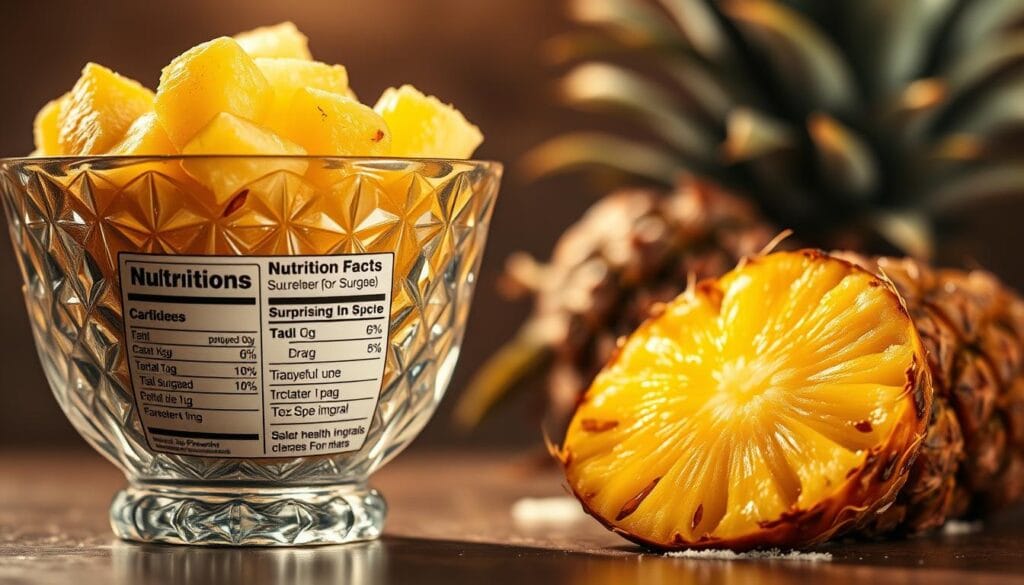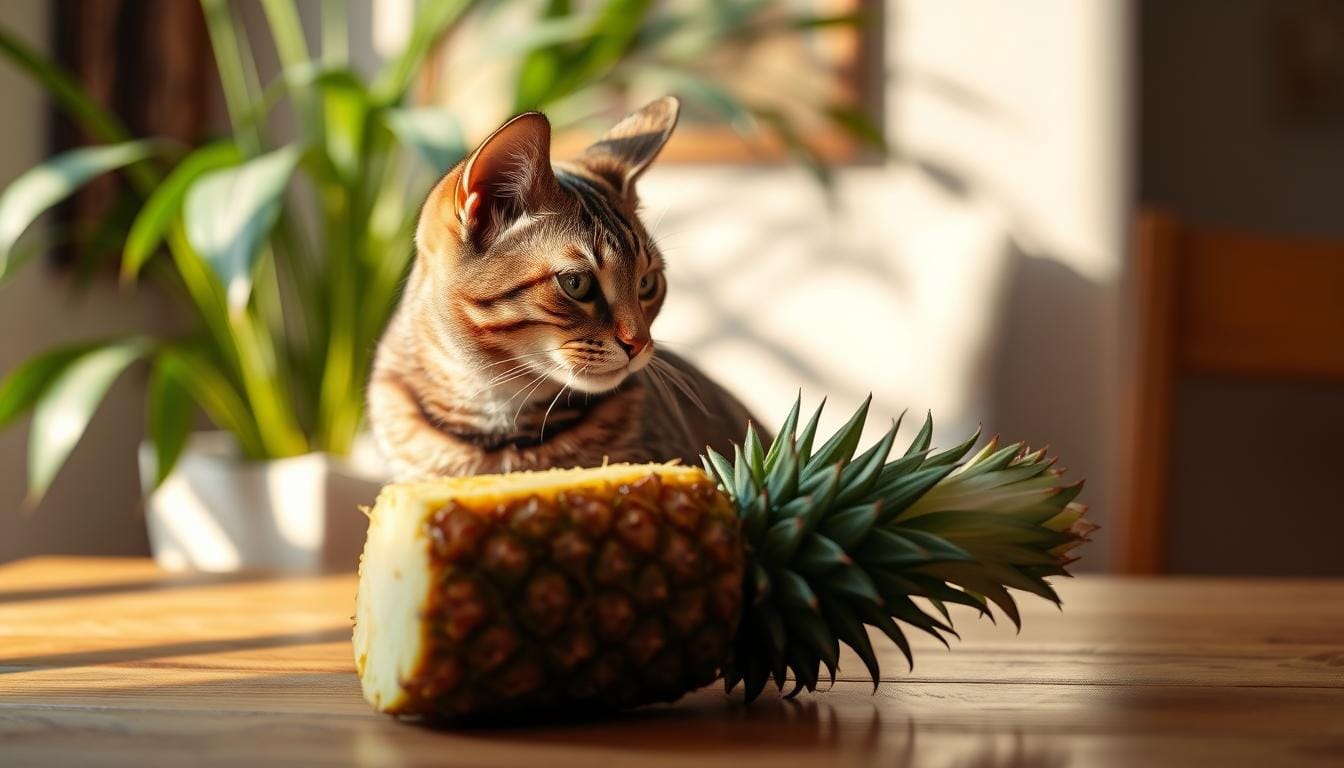Can Cats Eat Pineapple? Safety Tips for Cat Owners
Ever found yourself wondering what human foods your curious companion can nibble? Many pet parents feel that tug-of-war between wanting to share life’s flavors and keeping their furry friend safe. Today, we’re tackling a tropical twist in feline nutrition that’s likely crossed your mind during snack time.
The ASPCA confirms pineapple isn’t toxic to your whiskered roommate. While these meat-loving hunters thrive on protein-rich meals, occasional fruit treats can add variety. But before you slice that golden wedge, there’s more to consider than basic safety.
Table of Contents
This guide walks you through veterinary insights and nutritional science behind sharing this sweet treat. You’ll learn why portion control matters more than you might think and how to spot signs of digestive sensitivity. We’ve distilled official pet poison control recommendations into practical tips for responsible treat-giving.
Remember: every feline’s system differs. What works for one may upset another’s stomach. That’s why consulting your vet remains crucial before introducing new foods—even those deemed generally safe. Let’s explore how to balance your pet’s health with their natural curiosity.
Understanding Your Cat’s Dietary Needs
Your feline companion’s biology demands animal protein to thrive. Unlike humans, obligate carnivores rely on meat for essential nutrients their bodies can’t produce. This evolutionary design shapes their entire digestive process—from sharp teeth for tearing flesh to a short intestinal tract optimized for rapid protein absorption.
Commercial cat food meets these biological needs when formulated properly. Premium brands include critical components like taurine from chicken hearts and arachidonic acid from fish oils. These elements support heart function, vision, and immune health—non-negotiable requirements for your pet’s well-being.
| Essential Nutrient | Animal Source | Plant Source |
|---|---|---|
| Taurine | Beef liver | Not available |
| Vitamin A | Chicken fat | Beta-carotene* |
| Arachidonic Acid | Salmon | Algae (limited) |
While occasional plant-based treats might seem harmless, they lack the amino acid profile obligate carnivores require. Your pet’s system struggles to convert plant nutrients into usable forms—a key reason meat must dominate their meals. Always prioritize vet-approved formulas over experimental snacks.
Quality diet choices prevent nutritional gaps that could lead to health issues. Check labels for AAFCO certification, ensuring meals meet strict feline standards. This approach lets you balance curiosity with biological necessity when introducing new foods.
Can cats eat pineapple? Exploring Its Safety and Benefits
Curiosity about feline-friendly fruits often leads pet parents to question pineapple’s suitability. Veterinary experts confirm this tropical treat poses no toxicity risks when prepared correctly. The ASPCA specifically lists it as acceptable for occasional sharing, offering authoritative reassurance to cautious owners.

Research shows pineapple’s enzymes and natural sugars don’t harm healthy felines in tiny amounts. Unlike chocolate or grapes—known hazards—this fruit lacks compounds dangerous to carnivores. Always remove the spiky skin and hard core before serving to prevent choking or intestinal irritation.
Fresh chunks work best, as canned varieties often contain syrup with added sugars. Start with pea-sized portions once weekly, monitoring for digestive changes like loose stools. While most pets tolerate it well, individual sensitivities vary widely.
Consult your veterinarian before introducing new items to your pet’s menu. They’ll assess dietary needs and rule out conditions like diabetes that could make sugary treats problematic. Responsible treat-giving balances novelty with nutritional priorities, keeping animal protein central to meals.
Nutritional Benefits of Pineapple for Feline Health
Pineapple’s vibrant flesh hides a treasure trove of vitamins and minerals that might surprise you. This tropical fruit delivers vitamin C for antioxidant support and vitamin B6 for nervous system function. Though not essential for obligate carnivores, these nutrients offer supplementary advantages when given sparingly.
Key minerals like potassium shine in supporting cardiovascular health. This electrolyte helps regulate muscle contractions and fluid balance—critical for active pets. Magnesium teams up with calcium to maintain bone density, while zinc boosts immune responses against everyday threats.
The fiber content promotes gentle digestion despite feline systems requiring minimal plant matter. Small portions could help pets with occasional constipation, though excessive amounts risk stomach upset. Always prioritize protein-rich meals over fibrous snacks.
Rich in vitamins A and K, pineapple supports vision and blood clotting mechanisms. These compounds work synergistically with animal-sourced nutrients in complete diets. Think of fruit treats as complementary flavor experiences rather than dietary staples.
Consult your veterinarian to determine appropriate serving sizes based on individual health needs. While packed with beneficial compounds, this sweet snack should never replace balanced nutrition from quality pet food formulas.
Potential Risks and Considerations When Feeding Pineapple

Pet owners often overlook the sugar content in fruits deemed safe for feline companions. While pineapple isn’t toxic, its natural fructose levels challenge carnivorous digestive systems. Overindulgence may trigger vomiting or diarrhea—clear signs your pet’s body rejects the unfamiliar sugars.
Diabetic pets require extra caution. Their bodies struggle to regulate blood glucose, making even small portions risky. Always consult your vet before introducing new foods if your furry friend has metabolic conditions.
| Risk Factor | Potential Impact | Prevention Strategy |
|---|---|---|
| High Fructose | Digestive upset | Limit to pea-sized portions |
| Excess Calories | Weight gain | Treats ≤1% of daily intake |
| Nutritional Imbalance | Reduced protein absorption | Maintain meat-based diet |
Fresh pineapple flesh contains 10g of sugar per 100g serving—equivalent to three sugar cubes. Regular treats could lead to obesity over time. Stick to monthly offerings rather than weekly indulgences.
Monitor your companion closely after initial tasting sessions. Watch for lethargy, appetite changes, or litter box irregularities. These signals help determine individual tolerance levels.
Always prioritize veterinary guidance when modifying diets. Professionals assess underlying health issues that might make tropical fruits hazardous. Responsible pet parenting means balancing curiosity with biological realities.
How to Prepare Pineapple Safely for Your Cat
Preparing tropical treats for your pet requires precision and care. Follow these guidelines to transform this fibrous fruit into feline-friendly bites while avoiding common pitfalls.
Proper Cutting and De-Peeling Techniques
Start by removing the spiky skin and crown completely. These parts contain tough fibers that pose choking risks. Use a sharp knife to slice off the outer layer until only yellow flesh remains.
Discard the core and any remaining leaves—their rigid texture can irritate delicate digestive systems. Chop the fruit into pea-sized cubes, ensuring pieces match your companion’s bite capacity.
Serving Fresh versus Canned Options
Fresh pineapple remains the superior choice due to zero additives. Rinse thoroughly under running water to eliminate pesticide residues before slicing. Pat dry with paper towels to remove excess moisture.
If using canned pineapple, select varieties packed in water without syrups. Drain thoroughly and rinse to reduce sugar content. Never serve juice-soaked pieces—their sticky texture may cling to teeth.
| Feature | Fresh | Canned |
|---|---|---|
| Added Sugars | None | Common |
| Preservatives | Absent | Possible |
| Preparation Steps | Wash, peel, core | Rinse, drain |
Store prepared portions in airtight containers for up to three days. Offer sparingly—once monthly works for most pets. Monitor closely during initial tastings for adverse reactions.
Comparing Pineapple with Other Cat-Safe Fruits
Exploring feline-friendly fruits reveals a surprising variety beyond the tropical favorite. While texture and nutrition differ, several options share pineapple’s safety profile when served properly.
Nutritional Contrasts in Popular Choices
Strawberries stand out with lower sugar content than many fruits, making them gentler for sensitive stomachs. Their fiber-rich flesh supports digestion without overwhelming carnivorous systems.
Bananas offer comparable potassium levels but boast a creamier texture pets often prefer. Unlike pineapple’s fibrous chunks, this soft treat dissolves easily during chewing.
Melons provide superior hydration benefits, while blueberries deliver antioxidants lacking in tropical options. Rotating these food items creates diverse tasting experiences without nutritional overload.
Always introduce new fruits separately to monitor reactions. Consult your veterinarian to craft a balanced treat rotation that complements core meals. Moderation remains key across all snack choices.
- Can Cats Eat Blueberries? Benefits and Risks Explained
- Can Cats Eat Mango? What Every Cat Owner Should Know
- Can Cats Eat Grapes? Vet Answers and Safe Alternatives
- Can cats eat chicken and what are the health benefits?
- Can cats have chicken as a protein source? Comprehensive guide
- Can Cats Eat Raw Chicken? Safety Guide for Cat Owners
- Dry Cat Food Brands Loved by Cats and Trusted by Vets
- Best Cat Food for Sensitive Stomach:Top 5 Vet-Approved Picks
- Special Kitty Kitten Food – Learn the Pros and Cons
- prescription cat food-Top 10 Prescription Cat Foods
- Wet Cat Food for Kittens: Top Nutritious Choices 2025
- How Long Can Wet Cat Food Sit Out? Critical Facts
- American Veterinary Medical Association (AVMA)

